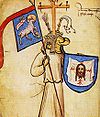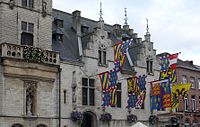Portal:Heraldry
Welcome to the Heraldry and Vexillology Portal!


Heraldry encompasses all of the duties of a herald, including the science and art of designing, displaying, describing and recording coats of arms and badges, as well as the formal ceremonies and laws that regulate the use and inheritance of arms. The origins of heraldry lie in the medieval need to distinguish participants in battles or jousts, whose faces were hidden by steel helmets.
Vexillology (from the Latin vexillum, a flag or banner) is the scholarly study of flags, including the creation and development of a body of knowledge about flags of all types, their forms and functions, and of scientific theories and principles based on that knowledge. Flags were originally used to assist military coordination on the battlefield, and have evolved into a general tool for signalling and identification, particularly identification of countries.
Selected article

Attributed arms are coats of arms given to legendary figures, or to notable persons from times before the rise of heraldry. Beginning in the 12th century, imaginary arms were assigned to the knights of the Round Table, and soon arms were given to biblical figures, to Roman and Greek heroes, and to kings and popes who had not historically borne arms. The specific arms could vary, but the arms for major figures soon became fixed.
Notable arms attributed to biblical figures include the arms of Jesus based on the instruments of the Passion, and the shield of the Trinity. Medieval literature attributed coats of arms to the Nine Worthies, including Alexander the Great, Julius Caesar, and King Arthur. Arms were given to many kings predating heraldry, including Edward the Confessor and William I of England. These attributed arms were sometimes used in practice as quarterings in the arms of their descendants. (more...)
Selected biography

John Philip Brooke Brooke-Little, CVO, FSA, FHS, (6 April 1927 –13 February 2006) was an influential and popular writer on heraldic subjects and a long-serving officer of arms at the College of Arms in London, England. In 1947, while still a student, Brooke-Little founded the "Society of Heraldic Antiquaries." This organization is now known as The Heraldry Society and is recognized as one of the leading learned societies in its field. He also served as the society's chairman for 50 years until 1997 and then as its President. (more...)
Selected flag

The national flag of Tunisia (Arabic: علم تونس) is predominantly red and consists of a white circle in the middle containing a red crescent around a five-pointed star. The Bey of Tunis Al-Husayn II ibn Mahmud decided to create the flag after the Battle of Navarino on 20 October 1827, which was adopted in 1831 or 1835. It remained the country's official flag during its time as a French protectorate, and was confirmed as the national flag of the Republic of Tunisia with the signing of the Constitution of Tunisia on 1 June 1959. It was not until 30 June 1999 that its proportions and design were clearly specified in law.
The crescent and star recalls the Ottoman flag and is therefore an indication of Tunisia's history as a part of the Ottoman Empire. (more...)
Selected picture

The town hall of Dendermonde, a city in Flanders, displaying heraldic banners.
Did you know...
- ...that, among the flags of Romania, the removal of the socialist coat of arms during the Romanian Revolution of 1989 gave rise to the phrase "the flag with the hole" (pictured)?
- ...that Donal McLaughlin, as part of a team led by Oliver Lincoln Lundquist, designed a logo for the 1945 United Nations Conference on International Organization that became the model for the Flag of the United Nations?
- ...that the coat of arms of Montenegro derives from that of King Nikola?
- ...that the Russian frigate Oryol was completed in 1669 as the first Russian naval ship, and flew the earliest recorded white, blue, and red Russian flag?
- ...that Arthur Bliss wrote A Colour Symphony after he came across a book on heraldry in which he read of the symbolic meanings attached to certain colours?
Related portals
|
|
|
Heraldry Web resources
Authorities
- Belgium - The Council of Nobility, Flemish Heraldic Council and Council of Heraldry and Vexillology of the French Community
- Canada - Canadian Heraldic Authority and see also Public Register of Arms, Flags and Badges
- England, Wales, and Northern Ireland - The College of Arms
- Ireland - The Office of the Chief Herald of Ireland
- Netherlands - High Council of Nobility
- Portugal - Instituto da Nobreza Portuguesa
- Scotland - The Court of the Lord Lyon
- South Africa - South African Bureau of Heraldry
- Sweden - National Board of Heraldry, The National Archive
- United States Army - The United States Army Institute of Heraldry
Societies
- Greek Heraldry Society
- The Academy of Heraldic Science Czech republic
- The American College of Heraldry
- The American Heraldry Society
- The Augustan Society
- The Australian Heraldry Society Inc.
- Bulgarian Heraldry and Vexillology Society
- The Center for Research of Orthodox Monarchism
- Cambridge University Heraldic and Genealogical Society
- Chiltern Heraldry Group
- The College of Dracology
- Croatian Heraldic and Vexillologic Association
- The Finnish Heraldic Society
- Fryske Rie foar Heraldyk
- Hellenic Armigers Society
- Guild of Heraldic Artists
- Genealogical Society of Ireland
- Heraldry Research Institute (Japan)
- The Heraldry Society
- The Heraldry Society of Africa
- The Heraldry Society of New Zealand Inc.
- The Heraldry Society of Scotland
- The Heraldry Society of Southern Africa
- The Institute of Heraldic and Genealogical Studies
- The International Association of Amateur Heralds
- Italian Center of Vexillological Studies
- Lancashire Heraldry Group
- Macedonian Heraldry Society
- New England Historic Genealogical Society Committee on Heraldry
- Norwegian Heraldry Society
- Oxford University Heraldry Society
- Polish Heraldry Society
- Polish Nobility Confederation
- Real Academia Matritense de Heráldica y Genealogía - Royal Academy of Heraldry and Genealogy of Madrid
- Romanian Institute for Genealogy and Heraldry
- The Royal Heraldry Society of Canada
- The Russian College of HeraldryThe Russian College of Heraldry
- Serbian Heraldic Society
- Societas Heraldica Scandinavica
- Societas Heraldica Slovenica
- Swedish Heraldic Society
- Ukrainian Heraldry Society
- Royal Association Genealogical and Heraldic Office of Belgium
Vexillology
Software
- Coat of Arms Visual Designer web-based program
- Puncher Heraldry Program
- Blazonry Server - pyBlazon
- DrawShield - creates SVG shield or arms image from blazon
- CoaMaker - web-based tool
- Blazon95 and BLAZONS! 2000, older Windows applications
Texts
- Heraldry, historical and popular : with seven hundred illustrations (1863)
- A Complete Guide to Heraldry (1909)
Other
Wikimedia
The following Wikimedia Foundation sister projects provide more on this subject:
-
Commons
Free media repository -
Wikibooks
Free textbooks and manuals -
Wikidata
Free knowledge base -
Wikinews
Free-content news -
Wikiquote
Collection of quotations -
Wikisource
Free-content library -
Wikispecies
Directory of species -
Wikiversity
Free learning tools -
Wikivoyage
Free travel guide -
Wiktionary
Dictionary and thesaurus












